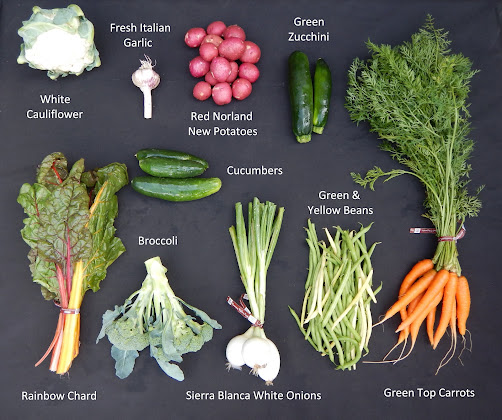What's In The Box
Red Norland New Potatoes: These red-skinned, white flesh potatoes were dug this week and have thin, delicate skin. Read more in this week’s vegetable feature article about what makes “new” potatoes so special. As you prepare and eat them, notice how crispy and juicy they are when raw. Also notice how their flavor is different from stored potatoes. Gently wash them before using, but don’t scrub too hard or the skin will easily come off. Eat them within about a week and store them in the refrigerator.
Fresh Italian Garlic: This week’s garlic was harvested about a week ago. While the exterior skin is starting to dry down, it is still considered “fresh” as it is not fully cured. You’ll notice the skin surrounding the cloves is still moist and may be a little difficult to remove. The cloves inside are juicy, crisp and have a bright flavor. Store at room temperature.
Fresh White Onions: This week’s onion variety is “Sierra Blanca,” a fresh, white onion intended to be eaten fresh. If left to dry at room temperature, it will form a very thin, dry skin, but it does not have a thick skin that would help it to store for months. This is an excellent onion to use raw on sandwiches and salads…. especially when sliced thinly.
Broccoli: Store broccoli in the refrigerator loosely wrapped in a plastic bag until ready to use it. Use the florets and stem to make a simple soup, stir-fry, or salad.
Cauliflower: We just transplanted our final crop of cauliflower that we’ll harvest later this fall, just before winter sets in! In the meantime, we have a bit more of our spring-planted crop to harvest for you.
Silver Slicer and/or Green Slicer Cucumbers: Salt will draw the moisture out of cucumbers. If you don’t want your cucumber salad to get soggy, salt the cucumbers first and drain off the liquid before adding them to the salad or mixing them with the dressing.
Zucchini and/or Scallopini Squash: You can’t go wrong when using zucchini to make baked goods! Zucchini has a high moisture content which helps to make baked goods that are moist! (Note: Some boxes may receive Sweetheart Cabbage or Kohlrabi in place of this item)
Rainbow Chard: This gorgeous bunching “green” is a summer green related to beets! You may use chard in any recipe calling for beet greens, but it may also be turned into the base for a raw salad, added to soups and stews, or simply sauteed with olive oil and garlic. Use both the leaves and the colorful stems.
Green Top Orange Carrots: This week we are transitioning form our early season “Nantes” variety to one called “Bolero.” We plant this variety a bit in the spring, but also again in the fall. It is known for its strong, vigorous green tops (that are also edible) and sweet, delicious carrots that are crispy and firm!
Green & Yellow Beans: Beans are a low calorie, high fiber food. While they may be eaten raw, they are more delectable if blanched or lightly cooked.
Recipe Suggestions & Inspiration For This Week’s Box Contents
Potato, Cauliflower & Green Bean Curry
Bacon, Potato & Swiss Chard Scramble
20 Swiss Chard Recipes That Highlight the Versatility of This Green
Vegetable Feature: New Potatoes
Parmentier Potatoes
.jpg) |
| Photo from www.greedygourmet.com |
- Preheat the oven to 400°F.
- Parboil the potatoes in a large pot of salted water over a high heat for 5 minutes. Do not overcook! They should still have a slight crunch to them.
- Once the potatoes are parboiled, drain them in a colander and let them rest for a few minutes to dry. Alternatively, pat them dry with a clean towel.
- While you are parboiling the potatoes, put the oil in a large roasting pan and place it in the oven. You want the oil to be hot but watch it carefully as you do not want it to get so hot it starts to smoke.
- When the potatoes are parboiled and dried, carefully remove the roasting pan from the oven and gently place the potatoes in a single layer.
- Turn them around a bit for all surfaces to get covered in oil.
- Return the pan to the oven and roast for 20 minutes. Then, stir in the garlic and fresh herbs.
- Roast for an additional 15 minutes or until the potatoes are golden and crispy.
- Season to taste and serve immediately!



No comments:
Post a Comment